Cliffhangers in Email: Boost Opens Rates with Open Loops
Imagine you’re glued to your couch, binge-watching Breaking Bad, heart racing as the screen fades to black on a jaw-dropping cliffhanger.
You have to know what happens next.
That’s the magic of an open loop, a storytelling trick that leverages psychology to leave you hanging and craving a resolution.
It’s not just for TV; it’s a game-changer for email marketing. Open loops, or cliffhangers, tap into our curiosity, making subscribers eager to open your next email. According to Keystone Click, this technique leverages our brain’s need for closure.
In this post, I’ll unpack the psychology behind why open loops work, explore examples from movies, books, and beyond, and show you how to use them in your email newsletter to skyrocket open rates. Ready to hook your audience?
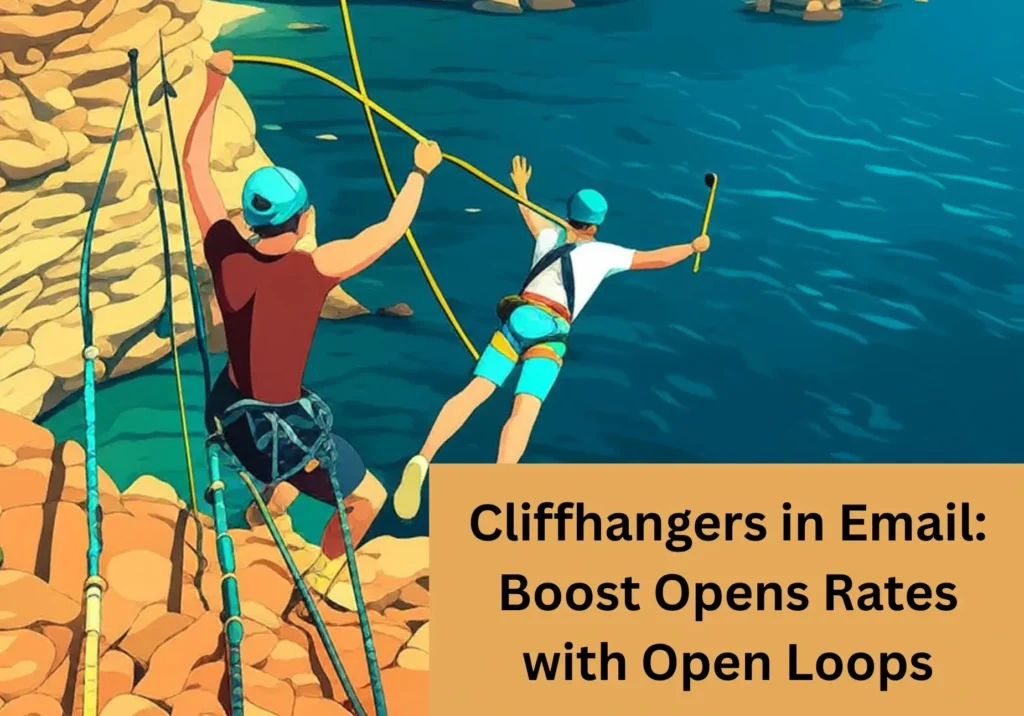
Let’s get started.
CONTENTS
The Psychology Behind Open Loops
Ever wonder why you can’t stop thinking about a movie that ended on a cliffhanger?
Or why you keep checking your phone for the next episode’s release?
It’s not just great storytelling; it’s your brain doing what it’s wired to do. Open loops, those tantalizing unfinished stories, hook us by tapping into deep psychological principles. Let’s break down the science behind why they work so well, and why they’re a secret weapon for your email marketing.
The Zeigarnik Effect: Your Brain Hates Loose Ends
Back in the 1920s, a psychologist named Bluma Zeigarnik noticed something curious while watching waiters at a busy café. They could recall complex orders perfectly, until the bill was paid. Once the task was done, poof, the details vanished from their minds. This led to her groundbreaking discovery: our brains remember unfinished tasks better than completed ones. It’s called the Zeigarnik Effect, and it’s like a mental itch you can’t ignore.
In email marketing, this is gold. When you tease a story or question in one email and leave it unresolved, it sticks in your subscriber’s mind. They’re more likely to open your next email to scratch that itch. A study by the American Psychological Association confirms that incomplete tasks create cognitive tension, pushing us to seek closure. Think of it as your brain saying, “Hey, finish this story already!”
Curiosity and the Dopamine Rush: The Need to Know
Now, let’s talk about curiosity. Imagine you get an email with the subject line, “This one mistake could tank your business…” You’re dying to know what it is, right? That’s because open loops create what psychologists call an “information gap.” George Loewenstein, a researcher at Carnegie Mellon, found that when there’s a gap between what we know and what we want to know, our brain lights up with curiosity. It’s like dangling a carrot just out of reach.
This curiosity triggers a dopamine rush, the same feel-good chemical that makes scrolling social media so addictive. A 2016 study in Nature Reviews Neuroscience explains that dopamine drives us to seek rewards, like answers to unanswered questions. In your emails, a well-crafted open loop—like hinting at a game-changing tip without revealing it—keeps subscribers hooked, eager for the next message to fill that gap.
But here’s the kicker: curiosity isn’t just about facts. It’s emotional. When you tease a story about a client’s dramatic turnaround, subscribers don’t just want the solution; they’re invested in the journey. That’s why open loops are so powerful, they make your emails feel personal and urgent.
Emotional Engagement and Arousal: Why You Can’t Look Away
Cliffhangers don’t just spark curiosity; they get your heart racing. Recall a TV show leaving you on edge—pulse up, mind racing, desperate for the next episode. A 2024 study from the University of Fribourg found cliffhangers spike emotional arousal, boosting engagement. It’s why you binge-watch.
In emails, this means higher open rates. A subject line like “She was about to lose everything until this change…” pulls readers in because they’re rooting for the outcome. This emotional pull, noted in a Harvard Business Review article, makes content a must-read. Even subtle loops, like teasing a stat, create enough arousal to keep subscribers coming back. The key? Make them feel something…excitement, anticipation, or frustration at not knowing the full story.
Open loops work because they tap into:
- Zeigarnik Effect: Keeps unfinished stories top of mind.
- Curiosity and Dopamine: Sparks craving for answers.
- Emotional Arousal: Heightens engagement.
These principles make open loops a psychological hook that’s hard to resist.
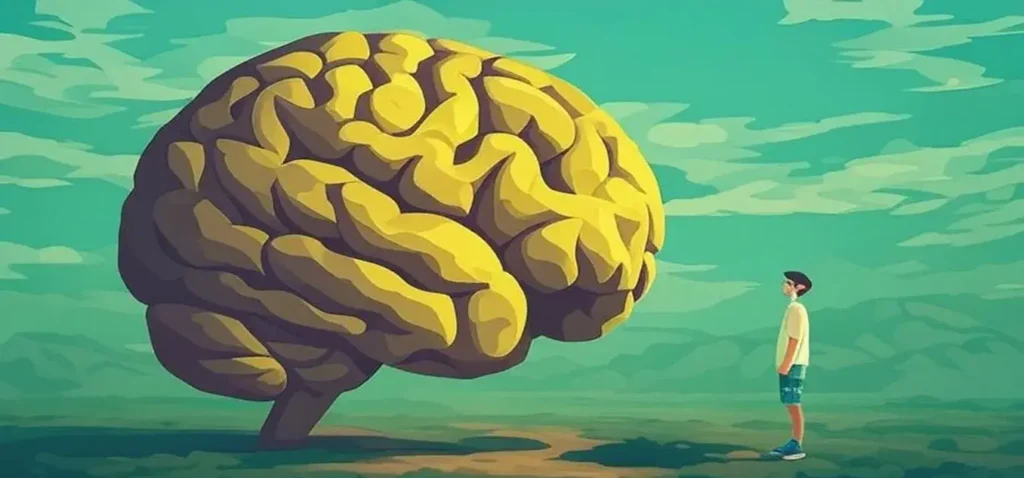
Open Loops in Action
You’ve felt it: that moment when a story leaves you desperate for more. Whether it’s a TV show fading to black or a book chapter ending with a twist, open loops are storytelling’s secret sauce. They’re not just for entertainment; they’re a masterclass in engagement.
Let’s explore how television, movies, and books use cliffhangers to captivate, and what you can steal for your email campaigns. These examples will make your subscribers just as eager for your next email.
Television Shows: Masters of the Cliffhanger
TV shows are kings at keeping you glued to the screen, and cliffhangers are their biggest weapon. Take Breaking Bad. In the season two finale, Walt’s secret teeters on exposure, and a shocking event leaves you reeling. You’re not just curious; you’re obsessed with what’s next. That’s an open loop at its finest, creating a burning need to watch the next episode.
Or consider Game of Thrones. In season five, Jon Snow’s fate hangs in the balance after a brutal betrayal. Fans spent months theorizing, unable to let go. A study by the University of California, San Diego notes that TV cliffhangers boost viewer retention by creating emotional investment. Shows use micro-loops (twists within episodes) and macro-loops (season-ending shockers) to keep you hooked.
For your emails, this is a playbook. A micro-loop could be a subject line like “What’s the one mistake killing your conversions?” A macro-loop might tease a big reveal over multiple emails. TV proves that leaving things unresolved keeps audiences engaged, and your subscribers are no different.
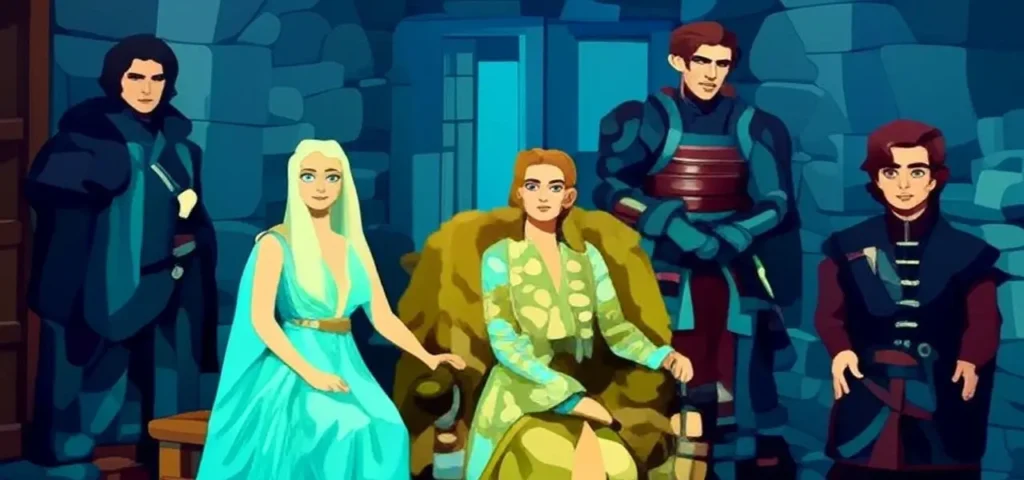
Movies: Big-Screen Suspense
Movies might seem like one-off stories, but the best ones use open loops to leave you hungry for more. In Avengers: Infinity War, Thanos snaps his fingers, half the universe vanishes, and the credits roll. You’re stunned, desperate for Endgame. That cliffhanger didn’t just spark talk; it packed theaters for the sequel. The University of Buffalo explains that movie cliffhangers create buzz by leaving audiences emotionally charged.
Take Star Wars: The Empire Strikes Back. Vader’s revelation about Luke’s parentage hits hard, and Han Solo’s fate remains unknown. Fans debated for three years until Return of the Jedi. That tension built a cultural phenomenon. Movies use open loops to extend engagement beyond the screen, through sequels or fan discussions.
In email marketing, mimic this. End an email with, “Tomorrow, we’ll reveal the strategy that doubled our client’s revenue…” Your subscribers, like moviegoers, will be eager for the next installment. Create a moment so compelling they can’t forget it, just like a blockbuster’s final scene.
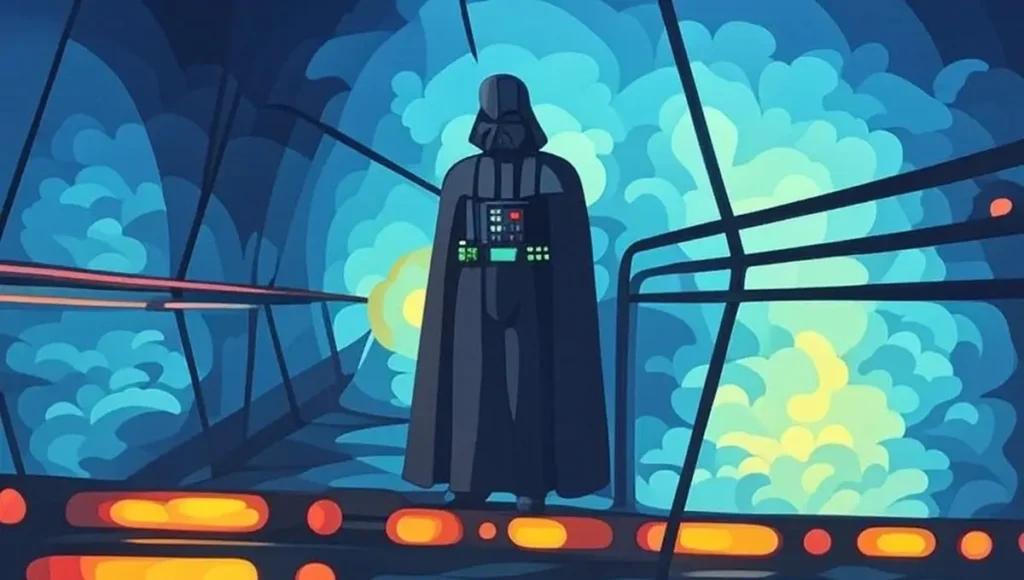
Books: Page-Turning Tension
Books move slower than TV or movies, but their cliffhangers are just as ruthless. In Harry Potter and the Order of the Phoenix, J.K. Rowling leaves you with unanswered questions about a mysterious prophecy. You’re racing to the next book to find out what it means. Rowling’s genius lies in chapter-ending twists that make putting the book down impossible.
George R.R. Martin’s A Song of Ice and Fire goes further. Major characters face shocking fates at chapter’s end, leaving you dangling for hundreds of pages—or years. A guide from Laterpress highlights how these cliffhangers build reader loyalty by keeping stories alive in their minds.
For emails, books teach pacing. Don’t reveal everything at once. Drop a hint in one email, like “This one change transformed her business overnight…” Deepen the story in the next before revealing the answer. Like a novelist, you’re building anticipation, making each email a page-turner subscribers can’t resist.
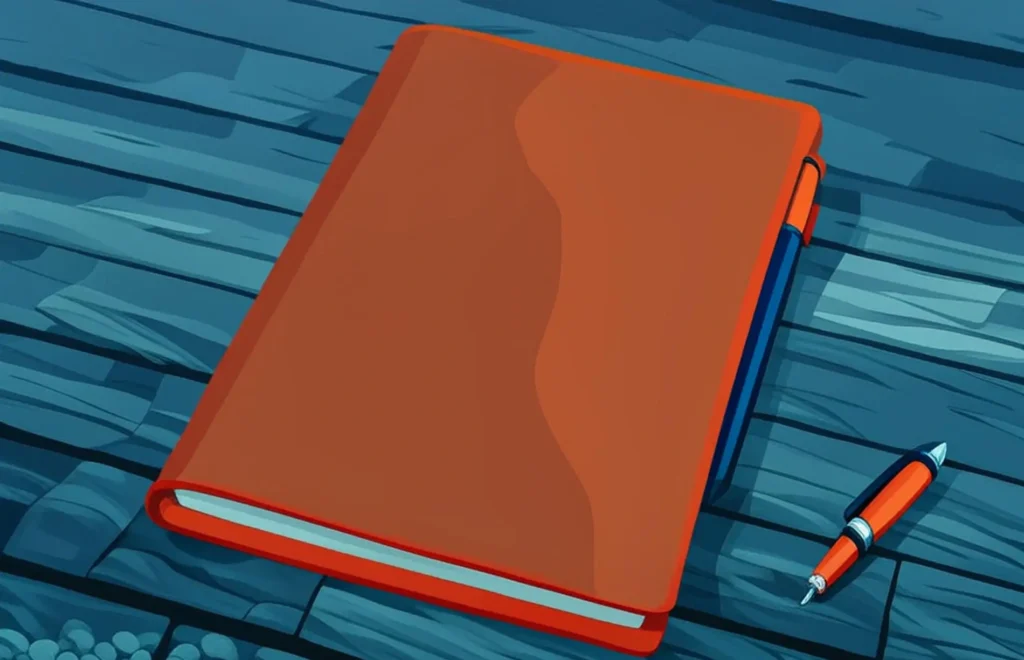
Why These Examples Matter for Your Emails
What do Breaking Bad, Infinity War, and Harry Potter share? They use open loops to create a cycle of curiosity and satisfaction. Each cliffhanger plants a question or emotion demanding resolution. Your newsletter can do the same by teasing a story or solution without giving it all away.
But there’s a catch: these examples work because they eventually deliver. TV resolves arcs, movies lead to sequels, books close loops (sometimes). Your emails must balance teasing with payoff to keep trust. These stories are a blueprint… tease something irresistible, leave it unresolved, and watch subscribers chase the rest.

Beyond Entertainment
Cliffhangers aren’t just for TV or novels. They’re everywhere, sneaking into daily life in ways you might not notice. From social media to ads, open loops grab attention. Let’s see how social media, advertising, and online courses use this trick, and how you can borrow their strategies for your newsletters.
Social Media: Teasing the Next Post
Scroll Instagram or X, and you’ll spot open loops. Humans of New York pairs photos with captions hinting at deeper stories. You’re left wondering about the person’s journey, checking back for more.
Brands and influencers do it too. Marketing expert Ryan Deiss posted, “I’m retiring soon… I’ll share why next week.” You’re curious about his reasons, so you keep an eye out for the follow-up. For emails, a subject line like “The secret to better conversions is coming tomorrow…” pulls subscribers back. Social media shows even short teases create powerful loops.
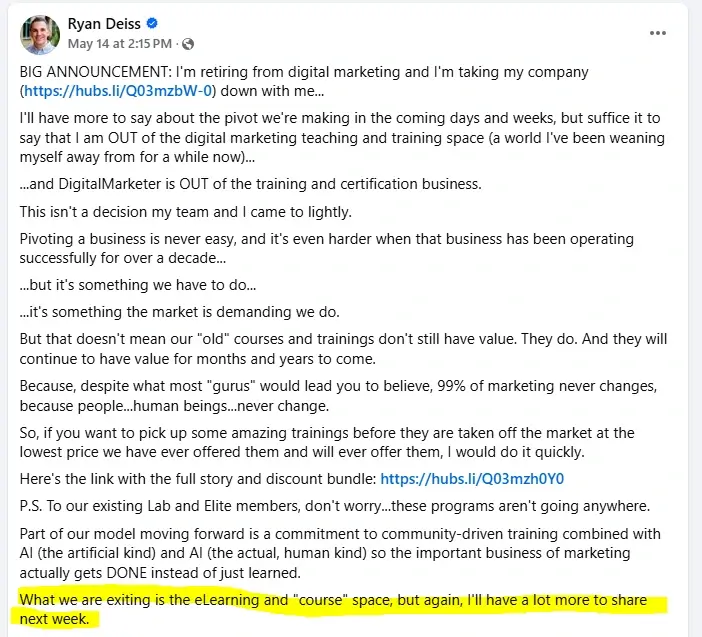
Advertising: The Click You Can’t Resist
Ads master open loops to drive action. Old Taster’s Choice coffee commercials told a serialized love story between neighbors, each ad ending on a “will they, won’t they” moment. Viewers tuned in for years. A marketing analysis by AdAge shows these narrative ads boosted brand loyalty.
The Taboola ad below teases growing ROAS by 1.26x. It’s a classic open loop that makes you click. You can do the same in emails by teasing a tip like, “One client’s mistake cost them thousands, find out what tomorrow.” Ads like these show how a clever cliffhanger gets clicks, and your newsletter can work the same magic.
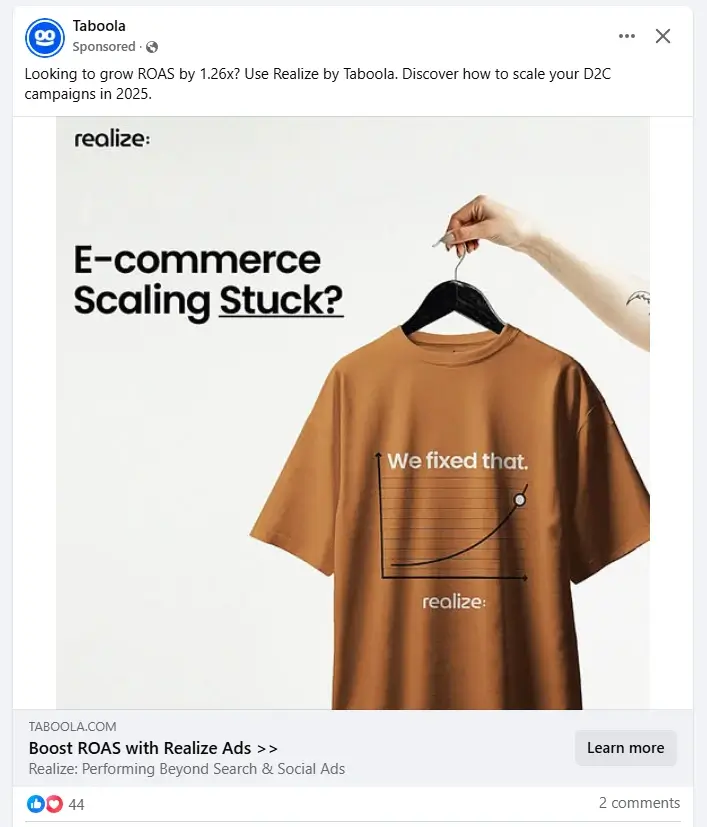
Online Courses and Surveys: The Push to Finish
Ever seen a course progress bar saying, “You’re 70% done” or “2 of 4 complete”? That’s an open loop, tapping your urge to finish. Surveys use it too: “Just three more questions!”
In emails, create a series teasing the next part, like, “Tomorrow, we’ll share the final step to skyrocket sales.” Subscribers feel compelled to “finish” the sequence. Courses and surveys show open loops don’t need drama—just make the next step essential.
These examples show open loops are everywhere, tapping our need for closure.

Why Open Loops Work in Email Marketing
You’ve seen cliffhangers captivate audiences in Breaking Bad and social media posts. But why do they shine in email marketing? Open loops tap the same psychological triggers—curiosity, anticipation, emotional investment—that make you binge-watch a series. They’re a game-changer for standing out in a crowded inbox.
Email marketing is tough. A 2024 report by Mailchimp shows average open rates hover between 20 and 30 percent. Most emails go ignored as subscribers drown in messages. Open loops are your secret weapon, making your emails impossible to skip.
They spark curiosity, build anticipation over multiple emails, and make subscribers feel invested, as we’ll explore in how to apply them. For example, Netflix teases new seasons with lines like, “Find out what happens to your favorite character…” A case study by HubSpot shows serialized campaigns boost engagement by keeping subscribers eager for more. But don’t overdo it… misleading teasers frustrate subscribers. Balance curiosity with value to keep trust high.
Open loops turn emails into conversations, not monologues. They leverage psychology to make subscribers crave your next message. Let’s see how to put this into action.

How to Use Open Loops in Your Emails
Picture your email newsletter as a TV series that keeps subscribers glued to their inboxes, waiting for the next episode. That’s what open loops can do—create cliffhangers that make your emails impossible to ignore. If you’re new to email marketing, don’t worry.
This section is designed for beginners, walking you through how to use open loops like a pro. I’ll start by explaining key terms, then show you how to build a compelling email series, and finally detail how to weave open loops into subject lines, email bodies, and P.S. sections.
Plus, I’ll cover how to keep your audience trusting you by delivering on your promises. Let’s make your newsletter a story subscribers can’t put down.
Key Terms for Beginners
To get started, let’s learn a few simple terms that’ll guide you through this process. Think of them as the building blocks of your email storytelling:
- Story Arc Series: A sequence of 5–7 emails that tells a story over time, like a season of your favorite TV show. Each email builds on the last, using cliffhangers to keep subscribers excited until the final action you want them to take, like buying or donating.
- Layered Loops: Several unresolved story threads running through your series, like plotlines in a drama. For example, you might tease a client’s struggle in one email and a product benefit in another, resolving each at different points to hold attention.
- Short-Term Loops: Small cliffhangers within one email, like a question that makes subscribers click a link or read to the end.
- Long-Term Loops: Bigger cliffhangers that stretch across multiple emails, keeping subscribers eager for the next message.
These terms work together to create emails that feel personal, urgent, and impossible to skip.
Building a Story Arc Series (SAS)
A Story Arc Series (SAS) is your chance to tell a story that unfolds over 5–7 emails, like episodes in a TV season. Instead of sending random emails, you create a sequence with a clear arc: introduce a character or problem, build drama, share a breakthrough, highlight benefits, and end with a call-to-action (CTA). Open loops—unresolved questions or stories—keep subscribers opening each email, waiting for resolution.
Here’s how to build one, step by step, using a nonprofit example:
- Welcome Email: Introduce yourself and start a story. “Thanks for joining our mission to change lives. Meet Maria, whose family faced a crisis last year…” Tease her struggle but don’t reveal the outcome, creating a long-term loop.
- Conflict Email: Deepen the drama. “Maria got an eviction notice with no warning. One choice could save her family… more on that tomorrow.” This long-term loop keeps subscribers curious.
- Breakthrough Moment: Share a turning point. “A donor’s gift gave Maria hope, but one decision changed everything. I’ll share it soon.” Add a new layered loop (the decision) to maintain interest.
- Unexpected Wins: Show broader impact. “That decision didn’t just help Maria… it lifted our community. Want to know how? Stay tuned.” Keep the anticipation alive with another loop.
- Resolution and CTA: Close loops and ask for action. “Maria’s family is safe, thanks to donors like you. That decision? A community fund we’re expanding. [Donate now to make a difference.]”
Keep your emails conversational, with short/pithy sentences, and use open loops to maintain the reader’s interest.
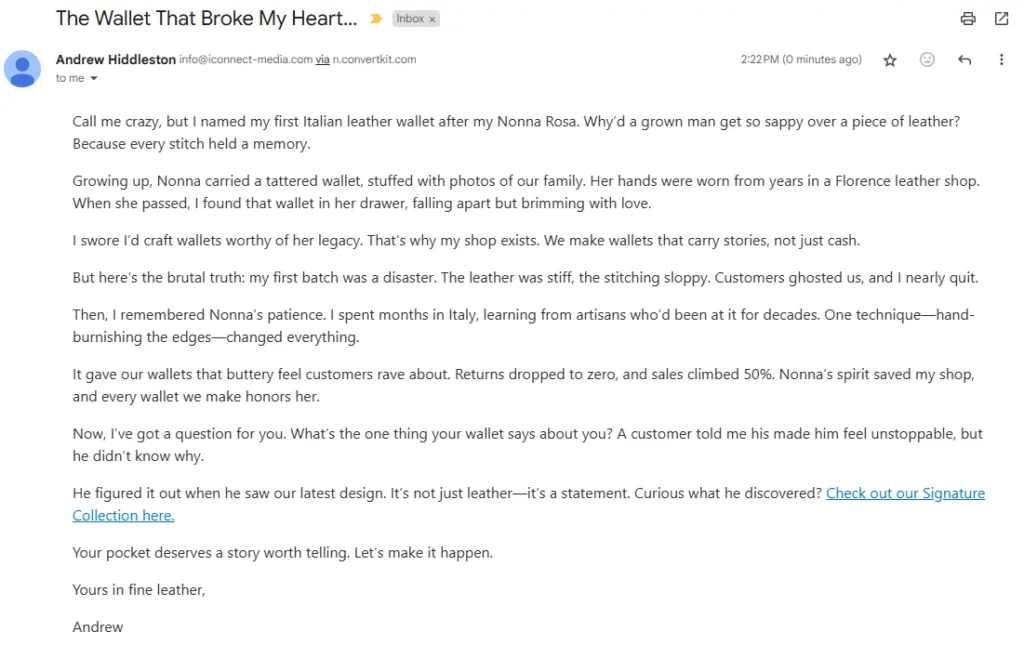
Using Open Loops in Your Emails
Now that you know how a Story Arc Series works, let’s see how to use open loops at every step of your emails. We’ll cover subject lines to grab opens, email bodies to drive clicks or next-email anticipation, and P.S. sections to keep curiosity burning.
Curiosity-Driven Subject Lines
Your subject line is like a movie poster—it has to grab subscribers and pull them into your email. An open loop teases a story or benefit without revealing all, sparking curiosity that drives opens. Instead of “Shop Our Wallets,” try “Why These Wallets Sell Out Fast…” It makes subscribers wonder: why?
Here’s a simple formula to create your own open-loop subject lines:
- Highlight a Problem or Tease: Start with a challenge or hint (e.g., “Why Your Ads Fail…”).
- Promise a Benefit: Suggest a solution or value (e.g., “…and How to Fix It”).
- Create a Curiosity Gap: Leave details vague to prompt a click (e.g., “Find Out Tomorrow…”).
Try these examples:
E-commerce (Italian Leather Wallets):
- Why These Wallets Sell Out in Hours…
- The Secret to Our Leather’s Timeless Appeal…
- What Makes Our Wallets a Status Symbol?
- This Wallet Design Mistake You’re Making…
- How One Wallet Changed His Style Forever…
Services (Medspa Laser Hair Removal):
- This Laser Mistake Leaves Skin Irritated…
- How Clients Get Silky Skin in One Session…
- Why Your Hair Removal Isn’t Lasting…
- The Medspa Trick Celebs Swear By…
- What’s Slowing Your Laser Results?
Nonprofit (Animal Rescue):
- One Puppy’s Rescue Changed Everything…
- How Your Gift Saves Kittens Tomorrow…
- This Dog’s Story Will Break Your Heart…
- What Stops 80% of Rescues? Find Out…
- The Donation That Gave Her a New Life…
These hint at value while staying vague, boosting open rates by up to 15%, per a Litmus study. Match your brand: bold for e-commerce, professional for B2B, heartfelt for nonprofits.

Email Body: Driving Clicks
Want subscribers to click through to your landing page, shop, or donation form? Open loops in the email body tease a story or solution just enough to spark action, like a movie trailer that leaves you craving the full film. Here’s how to craft them, even if you’re new to email marketing.
Click-Driven Body Formula:
- Share a Problem: Mention a relatable challenge you faced (e.g., “Our shop was struggling…”).
- Tease a Solution: Hint at what fixed it without details (e.g., “…until one idea changed everything”).
- Add a CTA Link: Invite clicks with an enticing link (e.g., “[Discover it now]”).
Try these examples:
- Charity (Animal Rescue): “Running our animal rescue, I watched too many puppies like Max face euthanasia. One idea saved him and dozens more, but we need your help to keep going. Learn how you can make a difference. [Donate to Save a Life.]”
- E-commerce (Italian Leather Wallets): “Last year, our wallet shop was losing ground to big brands. Customers loved our Italian leather but weren’t buying. Then, one design tweak made our wallets a must-have, and orders soared. Want to see what we changed? [Explore Our Collection Now.]”
- Services (Medspa Laser Hair Removal): “At our medspa, clients raved about laser hair removal but hated the wait for results. I was stumped until one technique cut sessions in half, giving smoother skin faster. Curious what we learned? [Book Your Session Today.]”
These loops create a knowledge gap, driving clicks. Keep the story short, emotional, and tied to your CTA.
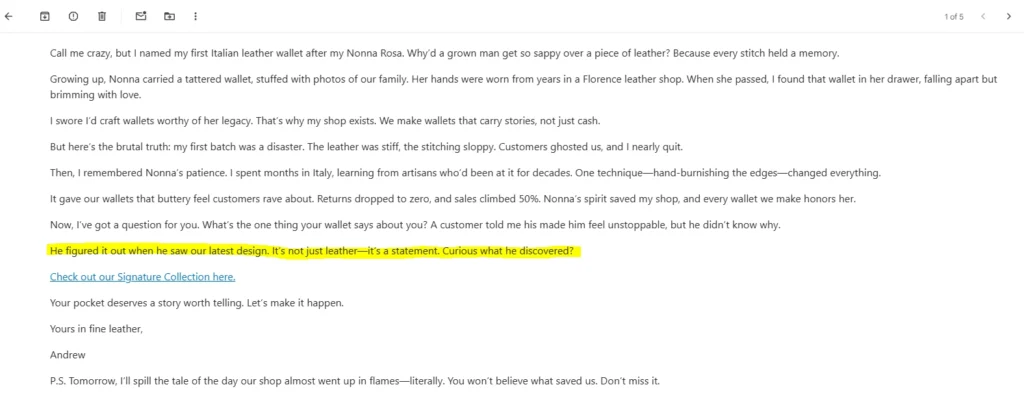
Email Body: Encouraging Next Opens
Want subscribers to eagerly await your next email, like fans counting down to a new TV episode? Long-term loops create cliffhangers that keep them hooked, ensuring they open your next message. Here’s how to craft them, even if you’re just starting out.
Next-Open Body Formula:
- Start a Story: Share a relatable challenge or moment (e.g., “Our shop hit a wall…”).
- Tease the Next Part: Hint at a resolution without details (e.g., “…one fix changed it all”).
- Promise Value: Assure subscribers the next email delivers (e.g., “Tomorrow, I’ll share how”).
Try these examples:
- Charity (Animal Rescue): “Running our animal rescue, I’ll never forget Max, a puppy facing euthanasia. One volunteer’s idea saved him, and it’s changing lives. How did we turn his story around? Check your inbox tomorrow for the full story.”
- E-commerce (Italian Leather Wallets): “Last spring, our wallet shop was struggling to stand out. Customers loved our Italian leather, but sales were flat. Then, one design choice sparked a frenzy—orders doubled overnight. What was it? Tomorrow, I’ll share the story behind our bestseller.”
- Services (Medspa Laser Hair Removal): “At our medspa, we hit a snag: clients wanted faster laser hair removal results. I thought we’d tried everything, but one technique slashed session times and left skin flawless. Curious what we discovered? I’ll reveal it in tomorrow’s email.”
I recommend using layered loops (e.g., a client story plus a product tease) to keep things dynamic.
P.S. Sections: Keeping Curiosity Alive
The P.S. section is your email’s post-credits scene—a final chance to plant a loop that lingers in subscribers’ minds, urging them to open your next email. It’s a small but mighty tool for keeping your Story Arc Series alive. They enhance engagement by adding an enticing, personal touch, per Mailchimp. Keep them short, tied to your series’ story, and irresistible to ensure subscribers stay hooked.
Here’s how to craft one:
P.S. Loop Formula:
- Tease Future Content: Hint at a story or insight coming next (e.g., “Tomorrow, I’ll share a game-changer…”).
- Create Urgency: Add a nudge to watch for the next email (e.g., “Don’t miss it!”).
- Keep It Brief: One or two sentences max for impact.
Try these examples:
- E-commerce (Italian Leather Wallets): “P.S. Tomorrow, I’ll reveal the one design secret that made our Italian leather wallets a bestseller. Stay tuned!” This teases a specific insight, keeping subscribers curious for the next email.
- Services (Medspa Laser Hair Removal): “P.S. Next time, I’ll share the technique that’s cutting our laser hair removal sessions in half. Don’t miss it!” This hints at a client benefit, urging anticipation.
- Charity (Animal Rescue): “P.S. In my next email, I’ll tell you how one donor saved a litter of puppies like Max. You won’t want to miss their story!” This tugs heartstrings and promises an emotional tale.
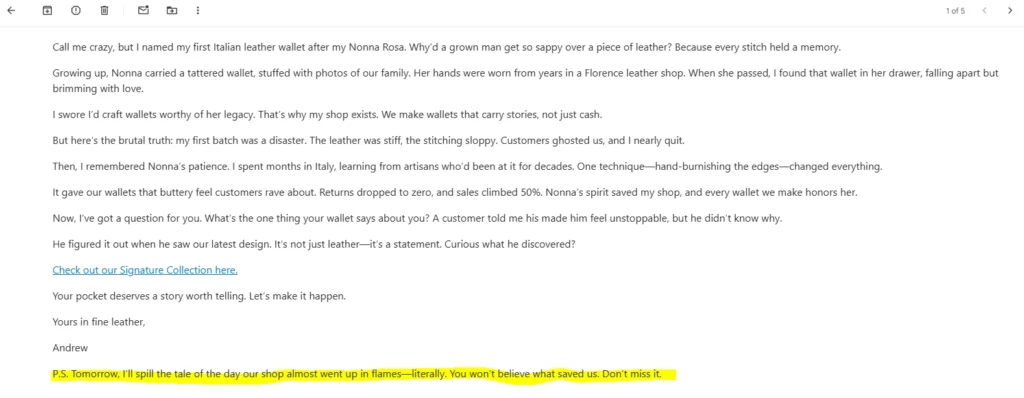
Balancing Curiosity and Closure
Open loops are only effective if you close them. Teasing without delivering frustrates subscribers, like a show that never resolves its mysteries. Trust is everything in email marketing, and broken promises can drive unsubscribes. Here’s how to balance curiosity and closure:
- Deliver value in every email: Share a detail or takeaway, like “Her store was failing, but one pricing shift sparked a turnaround. More tomorrow…” This satisfies while keeping curiosity alive.
- Close loops quickly: Resolve major loops within 2–3 emails. A nonprofit’s donor story might unfold over three emails, ending with impact and a new campaign tease.
- Mix content types: Not every email needs a cliffhanger. Blend open loops with standalone tips or updates so they feel like bonuses.
Use your Story Arc Series to weave Layered Loops, deliver value, and keep subscribers eager for your saga.
FAQs
What exactly is an open loop in email marketing?
An open loop is a storytelling technique where you tease a story, question, or solution without fully resolving it, creating curiosity that compels subscribers to open your next email. Think of it like a TV cliffhanger: a subject line like “This mistake nearly sank her business…” hooks readers by leaving them wanting more. It leverages the Zeigarnik Effect, where our brains crave closure for unfinished tasks, making your emails unforgettable.
How often should I use open loops in my email campaigns?
Use open loops strategically, ideally in 20–30% of your emails, to avoid overwhelming subscribers. A 2024 GetResponse report suggests curiosity-driven emails boost opens by 15%, but overuse can feel gimmicky. Mix them with value-driven content like tips or updates. For example, tease a story in a three-email series, but ensure each email delivers something useful to maintain trust and keep subscribers engaged.
Can open loops make my emails seem spammy or manipulative?
If poorly executed, yes, open loops can feel like clickbait. To avoid this, ensure your teasers are relevant and deliver on promises. For instance, don’t tease “a life-changing tip” and then push a generic sales pitch. Always provide value, even in teaser emails, and close loops within a few emails. Transparency builds trust, so align your cliffhangers with your brand’s voice and audience expectations.
How do I measure if open loops are increasing my open rates?
Track open rates and click-through rates using your email platform’s analytics. Compare campaigns with open loops to those without. A/B test subject lines, like “This strategy doubled sales…” versus a standard pitch. Monitor unsubscribe rates too—if they rise, your loops might be too aggressive. A HubSpot study shows storytelling campaigns can lift opens by 20%. Adjust based on data.
What’s the difference between an open loop and clickbait?
An open loop teases a genuine, valuable story or solution that you deliver, like a client case study unfolded over emails. Clickbait overpromises and underdelivers, like hyping a “secret” that’s just a sales pitch. Open loops build trust by closing the loop with meaningful content, while clickbait erodes it. Use authentic, relevant teasers to keep subscribers engaged without feeling tricked.
How do I avoid frustrating subscribers with unresolved open loops?
Close your loops within a reasonable timeframe, ideally within 2–3 emails, to avoid annoyance. For example, tease a tip in Email 1, share part of it in Email 2, and reveal the full solution in Email 3. Always include some value in each email, like a quick insight or statistic, so subscribers feel rewarded even before the resolution. This keeps them hooked without feeling strung along.
Can open loops work for all types of businesses?
Yes, open loops work across industries, from e-commerce to nonprofits, as long as they’re tailored to your audience. A retailer might tease a product launch, while a nonprofit could share a donor’s story. The key is relevance—your loop must address your subscribers’ interests or pain points. Test different approaches, like storytelling versus question-based teasers, to find what resonates most with your specific audience.
Start Creating Curiosity Today
The Zeigarnik Effect keeps unfinished stories in our minds, dopamine fuels our curiosity, and emotional investment makes us care.
In email marketing, open loops turn bland newsletters into must-read stories, boosting open rates by making subscribers eager for your next message.
Now it’s your turn. You don’t need to be a Hollywood writer to use this strategy.
First, grow your list with an open loop in your opt-in form, like, “Get the one secret that doubled our sales, sign up to find out!” Then, try open loops in your emails—start small with a subject line like “This one tip changed everything…” or tease a client story over a few emails. The key is to spark curiosity while delivering value, just like the case studies we explored.
Ready to captivate your subscribers?
Try open loops in your next email campaign or automation and see the difference. Contact our team for personalized services, whether you need help with a new custom website, SEO, or WordPress needs. Your audience is waiting for a story only you can tell.









